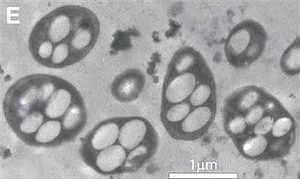In 2010, a NASA study published in the journal Science heralded the discovery of a bacteria, called GFAJ-1, which the authors at the time claimed it substitutes arsenic for phosphorus to survive. This contravened with the elemental recipe for life, where phosphorus is essential, stirring a wave of controversy within scientific community, as it would mandate a reformulation of the basic requirements for life on Earth. Recently, two separate and independent studies found that the claims were erroneous, disproving the paper.

The bacterium was found in Mono Lake, California. The lake doesn’t have any outlet to the ocean, which has lead along many thousand of years to an unusually salty body of water with high arsenic and mineral levels. Thus, a totally unique ecosystem was also formed. It’s these truly unique conditions that sparked NASA’s interest, as it resembles patches of Mars or even early Earth.
In the lake, scientists discovered the GFAJ-1 bacteria, which was found to be able to survive despite having arsenic in its DNA and cell membranes instead of phosphorus – a controversial claim, by all means.
Science has found that there are six critical elements indispensably required for life: carbon, hydrogen, nitrogen, oxygen, phosphorous and sulphur. Arsenic, though rather similar to sulphur, is not only missing from the aforementioned list, but poisonous for most living organisms. So, you can imagine what kind of uprising the claim that an organism which incorporates poison into its DNA stirred into the scientific community at the time. It had alien written all over it, and enthusiasts were quick to jump on the bandwagon.
From extraterrestrial back to terrestrial
The claim had to be confirmed by other separate, independent studies before it could have been deemed as a discovery. Two were recently published, both of which found flaws in the original paper.
One of the papers found that the bacterium was not really replacing phosphorus with arsenic throughout its DNA, but “may sometimes assimilate arsenate into some small molecules in place of phosphate.” The other paper tackled another significant claim; in the original paper from 2010, the authors stressed that the phosphor present in the samples was simply too low to accommodate life at all. The group, lead by Tobias Erb from the Institute of Microbiology, found that organism was incapable of surviving without some amount of the substance.
Some scientists, and science journalists alike, were quick to bash the authors of the original paper, lead by Felisa Wolfe-Simon of NASA’s Astrobiology Institute. Phrases like “bad science”, “sloppy research” and the likes were thrown a lot these past few days. I, for one, don’t agree. While I believe that the research could have been checked and even interpreted a lot more conservative, the finding is still important due to the very nature of this extraordinary organism. All the worse was for the better, if you’d like to see the half full side of the glass, since more attention has been directed towards it.
GFAJ-1 is a veritable extremophile. A survivor. It “is likely adept at scavenging phosphate under harsh conditions, which would help to explain why it can grow even when arsenic is present within the cells,” one of the journal entries reads; and what follows couldn’t better resonate with my own thoughts:
“The scientific process is a naturally self-correcting one, as scientists attempt to replicate published results,” it added.
Both studies were published in the journal Science.
source: 1 and 2






